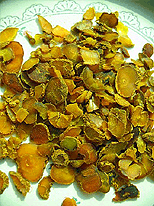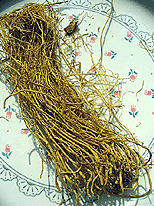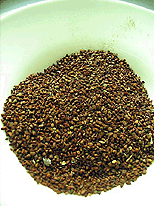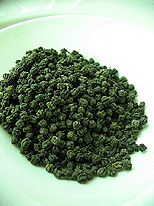1. Medicinal Suppositories
Herbs are made into a suppository form and inserted in the vagina or rectum for healing. According to the literature, this method had already been used for constipation during the Han dynasty (206 BC - AD 220) . Through its membranous absorption in the vagina and rectum, the herbs can exert a generalized effect.
The herbal suppository can be made from Chinese rhubarb and India madder root (qian cao) . Every night after washing, wrap the suppository with gauze and insert it deep into the vagina. It should stay in place for over four hours; warmth should also be applied concurrently to the lower abdominal region, 15-25 minutes each time.
|
|
|
Chinese rhubarb |
India madder root |
2. Umbilical Dressings
In TCM, the navel, which is also called shen-que, is an important acu-point of the body. It has a close relationship with the physiology and pathology of the internal organs, limbs and bones. By stimulating the navel, a medicinal effect infiltrates through the skin and reaches the meridians, activating the movement of qi and promoting internal balance.
An umbilical dressing is an important external therapy in TCM. Physicians prescribe herbs after a detailed consultation with the individual. They make the ingredients into dosage forms like cream, granules, pills, powder and soft extracts. The drug is pasted on the navel and covered by gauze or tape. Sometimes, physicians will combine this with moxibustion or hot compress therapies.
Sample dressing:
Herbs such as cassia bark, fennel, rhizome corydalis (yan hu sao), asarum, myrrh, frankincense and other invigorating herbs are ground into a powder. Take 5-10 g of this mixture each time, add millet wine and make into paste. Apply to the navel. Gauze is then wrapped around the waist to keep dressing in place. The paste should be changed daily until the menses arrive. This is suitable for women who have excessive coldness.
 |
 |
Rhizome corydalis (yan hu sao) |
Asarum |
3. Medicated Compresses
This is a kind of external application in TCM by pressing a pad of moistened linen or other material over the body surface repeatedly. There are two types: either wet dressings saturated with a herbal decoction or a topical compress of heated herbs packed in a bag. This therapy stimulates the communication of the striae, harmonizes the meridians and soothes the blood and qi circulation. The selected herbs are mainly fragrant and pungent in aroma, which enable them to be absorbed through the skin and so take effect. This is a popular Chinese family remedy.
Sample compress:
Prepare motherwort fruit (100 g), silkworm dung (100 g) and millet wine (100 ml). Stir-fry the ingredients, and then sprinkle the wine over it and keep stir-frying for a while. Pack the ingredients into a yarn bag and apply to the lower abdomen. Leave the compress on for 20 to 40 minutes or longer. If the bag turns cool, reheat it and apply once again. After finishing the compress, lay down to rest for several hours.
 |
 |
Motherwort fruit |
Silkworm dung |
4. Moxibustion with ginger
Prepare moxa cones and slice ginger into 0.3- 0.4 cm thick pieces and puncture small holes on them. Put the ginger slices on the acu-points guan-yuan and qi-hai, place a moxa cone on them and ignite it. When the patient feels a scorching sensation, the cone is removed and replaced with another. Around 5 to 7 cones may be applied until the skin is congested. Apply daily for 30 minutes for each section. Ten times make up one course.
5. Steaming and Washing Methods
Take 15 g each of fresh rehmannia rhizome, angelica, red peony root, peach kernel, salfflower, Trogopterus dung, Chinese rhubarb, peony bark and India madder root (qian cao). Boil with 1500 ml water for 30 minutes; pour the decoction into a tub. Take off the underwear, sit in the tub and cover the lower body with a large towel. Let the steam infiltrate the perineum region first; when the water turns warm, wash the region with the liquid until it turns cool. Apply daily for 30 minutes. Ten times make up one course.
|